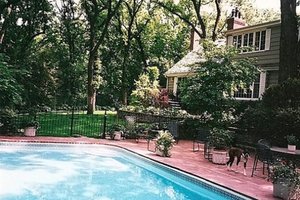By: Laura Fisher Kaiser
Scroll over, then click on photo to play video. For more videos and articles about home improvement visit our Resource Center.
Use tracing paper to plan out a landscaping project. Additional home improvement videos can be found at DannyLipford.com.
Landscaping is one of the surest ways to pump up the value of your property. According to research by Virginia Cooperative Extension, going from a plain lawn and a concrete driveway to a well-landscaped lot raises a home’s perceived value by 12.7%. The opposite is also true: A “minimal” landscaping job—a thoughtless smattering of scraggly plants—actually detracts from home value.
How much should you invest in upgrading your landscape? Professionals recommend budgeting 10% of your home’s value. But the important thing to remember is that success doesn’t depend on how much you spend. “Landscaping doesn’t have to be expensive, just well planned,” says Carl Heldmann, author of “Be Your Own House Contractor.” Here’s how to get started on a landscape plan of your own.
First, consult a pro
To figure out how to allocate your landscape dollars, start by picking the brain of a pro. Even if you have a naturally green thumb, a trained professional can save you from wasting money on wrongheaded ideas and open your eyes to possibilities you haven’t considered. There are various types of landscape pros, and their expertise is priced accordingly.
If your yard has major issues or you have grand ambitions, consider hiring a certified landscape architect to design a comprehensive plan that includes such things as irrigation, lighting, architectural features, soil conditioning, and, of course, the growing stuff. A verbal consultation costs about $100-$150; a detailed plan can run from $300 to $2,500. The American Society of Landscape Architects offers a state-by-state “firm finder” on its website.
Landscape designers typically charge less than degreed landscape architects and are a good choice for simpler projects that don’t require construction. Horticulturists specialize in plants, not necessarily design. Then there are landscape contractors, the design-build firms of yard work. Start by asking friends whose gardens you admire for recommendations. Your local home and garden center is another good source for contacts.
Set your priorities
Before you get any dirt under your nails—or hire someone to get dirty—you need to make two lists: a) what you want and b) what your property needs. These aren’t necessarily mutually exclusive, but the exercise is important for setting priorities. It would be folly to spend big bucks on an outdoor kitchen before resolving potentially disastrous issues such as a diseased tree or drainage problems.
The first question that a professional will likely ask is: What do you see yourself doing in your yard? Hosting Sunday barbecues? Doing the crossword puzzle in a hammock? Swimming laps? Growing vegetables? Clip pictures of outdoor spaces you like and don’t like to clarify the feeling you’re trying to achieve.
Remember that part of your landscape budget will go toward the “b” list. Those are things that may not lend themselves to sexy magazine spreads but can protect your property value—not to mention enhance your quality of life—by lowering water bills, reducing the need to mow or rake, or blocking the view of your neighbor who hot-tubs in the buff. We’re talking about practical considerations such as irrigation, fencing, lighting, equipment storage, privacy, and security.
Create a “floor plan” to target costs
To ballpark costs for materials and labor, think in terms of square footage, which is how landscapers charge. According to Costhelper.com, hiring someone to create a “naturalistic garden” averages $11 a square foot; the cost can double for a formal garden with walls and water features. And don’t forget to factor in long-term maintenance such as mowing, mulching, and pruning. (Sweat equity, anyone?)
If you’re designing your own plan, start by measuring your property or getting a plat survey from the county. You might even be able to find a topographical map indicating features like slopes and swales. You can sketch the basic layout to scale using old-fashioned graph paper or landscape design software. Prices have come down considerably on the latter, but quality varies widely, so check online reviews before purchasing. A free option: Google’s Sketchup, with cool apps for trees, pavers, shrubs, outbuildings, and the like.
Once you have the parameters, create a floor plan, marking off different sections just as you would rooms of a house. The front path is the foyer, there might be a “dining room” with a picnic table, a shady “bedroom” for a hammock, a “rec room” with play equipment. Consider the costs for each area of your plan, including materials, equipment, furnishings, greenery, and any specialized labor like irrigation or electricity.
Think long term
If your ambitions exceed your wallet (and whose do not?), go back to your priority list and pick a section or projects to tackle as your budget permits, advises Angela Dye, principal designer/president of A Dye Design, a landscaping firm in Phoenix, Ariz. “What is the absolute most important thing you need to have done?” she asks. “What is bugging you most?”
A carefully conceived plan will keep you on track during this gradual transformation, both in terms of vision and budget. And remember that patience pays off. “Additions or renovations can start losing value once completed,” says Jim Lapides, spokesman for the American Society of Landscape Architects. “A landscape literally grows in value over time.”
Laura Fisher Kaiser is a contributing editor to Interior Design magazine and a former editor at This Old House magazine. The secret to her Washington, D.C., garden is blood, sweat, tears, and mosquito repellent.
Video provided by Today’s Homeowner host, Danny Lipford.
Used with permission of the NATIONAL ASSOCIATION OF REALTORS®. Copyright 2010.






 The Federal Government continues to provide incentives to
The Federal Government continues to provide incentives to